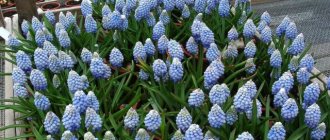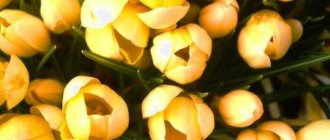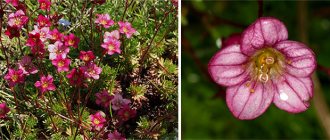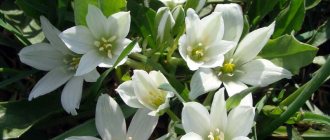Description and characteristics of crocuses
Corm perennials do not have an aboveground stem. The flowers are large, looking up. The six-petalled flowers are goblet or star-shaped and emerge directly from the bulb. Different shades of pink, purple, yellow, lilac, orange and lilac appear immediately after the snow melts.
The peduncle reaches up to 18 cm in height. The flowers are large, up to 7 cm in diameter, with a deep orange pistil. Narrow linear leaves grow during the flowering period or after the flower withers (in spring species).
Important! Saffron blooms only on a good, sunny day, flowering lasts 3-4 weeks. In cloudy and rainy weather, the petals are tightly closed into an unusually beautiful bud.
Origin
Crocuses are mysterious flowers; they are covered with various legends and myths. One ancient Greek myth tells of Mercury accidentally killing his friend Crocus. And at the request of Mercury, the gods perpetuated the memory of Crocus. Flowers grew where the young man shed his blood. Every spring these flowers were a reminder of eternal memory.
Another myth is about the young man Crocus, who fell in love with a beautiful nymph. The girl got bored with the passionate courtship, and she turned to the gods. And they turned the young man into a delightful purple flower with deep orange anthers, symbolizing fiery passion.
The flower has two names:
- crocus, from the ancient Greek kroke (thread) - the stigmas of the flower resemble fibrous threads;
- saffron - from Arabic sepheran (yellow).
The Arabs were the first to grow crocuses in the East. Potions and seasonings were prepared from flowers, but they were valued as a natural dye. In ancient China, there was a ban on the use of saffron dye, as it was intended only for the imperial family.
In Europe, the flower became known in the 11th century. It was bred only for economic purposes. The first decorative crocus was brought out only in the 16th century. The country of origin of the flower is considered to be Kashmir (India). According to Buddhist legends, the crocus to Kashmir was sent from heaven by the arhat Nimatun himself. In Tibet, the precious flower is used to produce Tibetan smoking sticks.
Types, varieties
Crocuses are divided into late-blooming and early-blooming, as well as by color and flower size.
Species that bloom in spring
Adams is a lilac flower. The height of the peduncle is 4-6 cm. Flowering occurs in early spring.
Alatavsky - peduncle height 8 cm. The perianth is painted purple on the outside, white on the inside. Blooms in early April.
Banatsky - a tall peduncle produces lilac flowers with bright yellow anthers and lilac stigmas.
Spring - low peduncle. Flower up to 5 cm in diameter. The species has a variety of colors, depending on the variety:
- “Agnes”, “Vangard” - pale lilac color;
- “Joan of Arc”, “Kathleen Parlow”, “Snowstor” - the flower is painted white;
- “Purpureu Grandiflore”, “Remebrance”, “Flower Record” - purple flower;
- "Little Dorrit" - the flower has a blue color with a silver tint.
All varieties bloom in April.
Golden-flowered - peduncle - 8 cm. The flowers are medium-sized, painted yellow or blue.
Large-flowered varieties:
- "Blue Pearl" - pearl blue color;
- "Violet Queen" - purple;
- "Cream Beauty" - yellow;
- "Snowbanding" - white;
- Heuffelliana - 12 centimeter peduncle, produces large flowers of purple, white or lilac, bloom in early spring.
Late flowering species
- Palassa is a late flowering species. Peduncle up to 6 cm high, petals pink-violet with purple veins. The flower blooms at the end of September.
- The beautiful crocus is a large, lilac-violet flower, reaching a size of up to 12 cm. The garden begins to smell fragrant in early autumn.
Popular varieties:
- "Albus" - white;
- "Artabir" - lilac;
- "Cassiope" - blue;
- "Oksonion" - dark blue;
- "Pallux" - light purple.
The flowering time of crocuses depends on the climate and place of growth.
Important! Saffron does not have red flowers.
Large-flowered crocuses or Dutch hybrids
Varieties of this culture are distinguished by their fertility and unpretentiousness. They bloom in spring. At the end of the 19th century, the first varieties of Dutch hybrids appeared. Now more than fifty of them are known. Hybrids were divided into groups according to the tone of the inflorescences:
- The first group includes crops with white inflorescences, which have spots in each bract element.
- The second group consists of species with all shades of purple.
- The third group combines varieties with stripes, mesh or spots.
Dutch crocuses bloom in May for 11-20 days. The following varieties feel good in the middle zone:
- Albion - goblet-shaped flowers have a diameter of 4 cm;
- Vanguard - open flowers of lilac-blue tone with darker small spots;
- Jubilees - blue, goblet-shaped flowers with a purple tint;
- Kathleen Parlow - white flowers with short purple streaks.
Dutch hybrids
When to plant crocuses
The timing of planting a spring flower depends on the species. Spring - for autumn varieties; autumn – for early flowering species. In spring, late-blooming varieties of crocuses are planted. For saffron, choose a sunny place. Planting is carried out in moist soil, in warm but not hot weather. For early, beautiful flowering, spring-flowering saffron is planted in early autumn.
The depth of the bulb depends on the quality of the soil:
- deepen into light soil to the depth of two bulbs;
- in heavy soil - the bulb is planted to a depth of its size.
The distance between the bulbs is 3-5 cm. After planting, the bulbs are watered.
By planting saffron in the fall, the bulbs will take root and overwinter well, and in the spring they will diversify the garden with bright flowering.
Important! If you plant a spring variety in the summer, the saffron will be able to bloom at the time of frost, which will lead to the death of the plant. And when planted in cold October, the bulb may not take root in the cold soil.
Planting in open ground in spring
At the end of March - beginning of April, planting of crocuses begins, which will bloom in the fall. The bed is prepared from the first cold weather, dug well, fertilize and drain the soil. In the spring, it is enough to thoroughly loosen the soil before rooting the bulbs.
They are planted according to the same scheme: in a heap, at a depth equal to three sizes in length. If all conditions are met, the plants will bloom in the year of planting.
Also in the spring months, flowers are planted after home forcing. Crocus bulbs in an indoor pot planted in January-February will delight you with delicate flowers for the 8th of March holiday. This is a touching and beautiful gift.
At the end of April - beginning of May, when there are minutes of frost on the soil, the flower can be transplanted outside. There it will complete its growing cycle, and next year, in early spring, it will bloom again.
Landing for forcing
The flower can also be grown from late winter to mid-spring. Thanks to forcing, saffron can be forced to bloom at any time. Varieties with large flowers are suitable for forcing: “Jeanne d'Arc”, “Pickwick”, “Striped Beauty”, etc.
The most beautiful flowering is produced by bulbs measuring 10 cm or more. Such corms are capable of producing 5-6 peduncles. The month of planting is determined by the desired flowering period. For planting, bulbs are selected of the same size. Up to 10 bulbs are placed in a flat, wide container to a depth of no more than 5 cm. After 1.5 months, the planted crocuses will turn into a beautiful flowering arrangement.
For early flowering, large corms are selected. Purchased bulbs are stored at a temperature of +17 degrees until planting. When forcing your own seed, it is necessary to subject it to temperature treatment. Saffron is also a house flower. It is grown for holidays and for home decoration.
For forcing for the New Year holidays
The bulbs are dug up in June. The seed is kept in the sun:
- week - optimal temperature +34 degrees;
- 14 days – + 20 degrees;
- until mid-August – + 17;
Before planting, the bulbs are stored at a temperature of +9 degrees. Bulbs are planted in late September.
For the spring holidays
The bulbs can withstand:
- until August the temperature is +20 degrees;
- further until landing – +17.
Landing takes place from early October to mid-November. In the fall, saffron that has been driven out can be safely planted in a personal plot.
Botanical description
Crocus flower refers to plants that reproduce using bulbs. Their tubers are round in shape. in diameter they usually do not exceed 3 cm. A bunch of roots emanate from them, the color of which may vary depending on the type of plant. Small scales form near the root system of saffron, which make this flower similar to a tulip.
Crocuses are small flowers that decorate the garden
The height of the perennial stem is usually between 20-25 cm. The flowers are glass-shaped. They are usually represented by 6 petals, the color of which can be either one-color or two-color. The stamens of the plant are always orange or yellowish in color.
History of appearance
Crocus was known even before our era. It was grown in the east, specifically in Persia, Ancient Egypt and China. Since the 16th century, saffron appeared in Europe and gained wide popularity among gardeners.
Features of the plant
The plant is a low-growing crop that blooms in the spring as one of the first flowers. The peculiarity of the crocus is that its bulbs are considered edible, and therefore are eaten after baking or boiling.
Beneficial features
Crocus contains a number of useful components, thanks to which it is of particular importance in cosmetology. Saffron can have a positive effect on the cardiovascular, genitourinary, nervous and digestive systems. It also allows you to remove waste and toxins from the body, due to which the skin acquires a healthy color, and nails and hair become stronger.
Note! Before using crocus, it is important to consult a specialist. He will write out instructions that must be strictly followed.
Use in cooking
The beneficial properties of the plant, as well as its beautiful appearance and aroma, have made it possible to use the perennial in cooking. The spice obtained from pistils is used as a seasoning for meat, fish, vegetables and even desserts. With its addition, dishes become brighter and more flavorful.
Saffron is often used as a spice
Crocuses planting
To get a beautiful flower bed of crocuses you need:
- choose a place:
- prepare the ground;
- select bulbs;
- prepare seed for planting.
Selecting a location
Saffron is divided into autumn and spring flowers, and therefore the location is chosen taking into account the flowering period.
Remember! Spring-blooming crocuses need plenty of light.
Autumn varieties grow well in shaded areas, under tree canopies or in compositions with low-growing conifers or evergreens. Spring varieties of saffron do not bloom in the shade, and the autumn variety Sharayana grows much worse in direct sunlight than in partial shade.
Crocuses are planted in groups. To create a beautiful saffron carpet, the bulbs are planted in a 3x3 grid. Per sq. There should be 50 bulbs per meter.
Saffron will also look beautiful in flower beds and flower beds, among spring bulbous plants: daffodils, tulips, hyacinths. This combination will ensure continuous early flowering and provide a spring mood.
Important! Before planting in open ground, the corms are treated in a “Maxim” or “Fundazol” solution. The treatment provides immunity from many diseases.
Crocuses look harmonious in rock gardens. After they wilt, bare areas can be covered with ground cover plants.
Once every five years, saffron is dug up and replanted, since due to the daughter bulbs being formed, there is not enough space for the plant to develop well, and the children take all the nutrients from the ground for their growth.
Soil preparation
Crocuses are very demanding on the soil. It should be light, fertile and well drained. Bulbs may rot in wet soil. If the soil is heavy and clayey, dig it up and add sand, lime or compost.
Sandy soil is poor in mineral elements. Therefore, when preparing the site, peat or leaf humus is added to the ground at the rate of 7 kg per square meter. meter. Loamy or sandy soil does not need to be fertilized. Before planting, the soil is dug up onto the bayonet of a shovel.
Bulb selection
Before purchasing, the bulbs are carefully inspected. They should be free of mechanical damage, signs of disease and rot. The bulbs must be strong, without roots or overgrown stems.
Important! A soft and broken onion is the first sign of rotting.
How to prepare crocus bulbs for planting
Before planting in open ground, bulbs are treated with fungicides to prevent diseases. “Maxim”, “Vitaros”, “Fundazol” or a weak solution of potassium permanganate are suitable for this.
For quick germination, the bulbs are soaked in a growth stimulator: “Kornevin”, “Epin” or “Zircon”.
Important! Before using fungicides and stimulants, you must carefully study the instructions for use.
The bulbs are dipped into the prepared solution and left for half an hour. After processing, you can begin planting in a permanent place. There is no need to dry or wash them.
Crocus planting technology
There are many varieties of crocuses. They differ in color, size and flowering time. Crocuses are divided into autumn and spring varieties.
Autumn varieties of saffron are planted in the spring. Landing occurs at the end of August - beginning of September. Planting too late leads to improper formation of the corm. As a result, the plant will produce a large amount of foliage, but will not flower. The weather during spring planting should be warm, but not hot.
Autumn-blooming varieties are often found in bloom on sale. Planting such flowers is carried out as follows:
- Leaves and flowers are trimmed from the bulb. This procedure will allow the plant to quickly adapt to a new location.
- It is better to buy the plant in a non-flowering form, since the peduncle greatly depletes the tuber.
- When planting such a plant, flowering occurs only the next season.
Autumn planting is intended for early flowering species. The month of planting depends on climatic conditions. The soil should still be warm and moist. After the onset of cold weather, it is better not to plant the plant, since the cold soil will not allow the bulb to germinate and it will die.
The technology for planting crocuses in autumn and spring is the same. For all species, prepare nutritious and moist soil. Treated bulbs are planted to a depth of 4 to 10 cm, the depth depends on the size of the bulb. Large ones are buried, small ones are planted closer to the soil surface.
Important! After flowering, the expanded root system pulls the tuber deep into the ground. And if crocuses are planted for forcing, they are buried in the ground, if for propagation, they are planted shallowly.
Note to the florist
"Crocuses - soldiers of spring"
What to do after the crocuses bloom?
At the end of the flowering period, approximately in mid-June, it is necessary to cut off dry inflorescences and leaves, and also dig up the corms. Planting material should be stored with a gradual decrease in temperature. During the week after digging, the corms are dried and ventilated. They can then be stored in a cellar or basement where it is cool and dark enough. After a few weeks, the planting material is transferred to a vegetable drawer in the refrigerator and stored there until planting. Crocuses are planted in the second half of September or early October.
Why don't crocuses bloom?
The absence of inflorescences, as a rule, indicates improper care of the plant.
Causes:
- The corms were dug up before the dormant period. Thus, the flower’s development cycle is disrupted, which entails the absence of flowers on the plant;
- Also, you should not cut off the crocus leaves ahead of time, as the plant may not form buds next year. You can trim the leaves only after they have completely dried;
- To stimulate abundant and long-lasting flowering after digging, the corms must be stored at a fairly low temperature;
- Crocuses stop blooming if they grow in one place for a long time and do not rejuvenate. To rejuvenate the plant, it is necessary to dig up the corms once every three to four years, divide them and plant them. However, some gardeners recommend carrying out this procedure annually.
In addition, quite often during storage in winter, corms are damaged by rodents, as a result of which crocuses do not form buds in the spring.
Why don't crocuses bloom in spring?
Many gardeners, when buying corms, do not pay attention to the flowering period. It is generally accepted that all crocuses bloom in the spring, however, this is not true. There are varieties that bloom in autumn. The two types of crocuses differ in their development cycles and therefore require slightly different care.
Caring for crocuses after planting
Saffron is not demanding in care and is practically not affected by diseases. For its growth and flowering, you must follow several rules of care:
- watering;
- feeding;
- loosening and removing weeds;
- getting rid of wilted leaves and flowers;
- mulching the soil for the winter.
After the shoots appear, the ground around the plant must be carefully loosened and weeded to allow air to reach the roots. Loosening is carried out immediately before watering. This allows moisture to quickly penetrate to the lower layers of the soil.
The plant is drought-resistant and needs watering only during winters with little snow, dry spring and during the flowering period. In summer, the plant enters a dormant period and will not need watering.
Important! When watering, you need to make sure that water does not get on the petals, as drops of water lead to darkening of the flower.
Crocuses need three feedings.
The first feeding is applied immediately before planting the bulb. For rapid growth, the plant needs phosphorus-potassium fertilizers. Potassium should be contained 2 times more than phosphorus. Nitrogenous fertilizers are applied directly into the hole.
The second is during the period of budding and flowering. During this period, the content of potassium and phosphorus is selected in equal parts, since phosphorus plays a large role in the formation of buds and is responsible for the duration of flowering.
The third is after flowering. The content of potassium and phosphorus in the fertilizer should be in equal parts. Crocuses can also be fed with organic fertilizers; compost is used for this.
The most suitable mineral fertilizers for good growth:
- Nitroamoffoska - improves growth, promotes the formation of buds and prolongs flowering.
- Kalifos-N – necessary during the growing season. Improves development and provides immunity to many diseases.
- Azofoska is a complex fertilizer that increases resistance to diseases and enriches the soil with all necessary microelements.
- Superphosphate - used at the beginning of flowering.
- Kemira is a complex fertilizer that improves growth and development, and also protects against fungal diseases.
Important! When planting in autumn, complex and organic fertilizers are not applied.
Plant care after flowering
In June and July, the leaves of crocuses begin to dry out. If the plant remains until the next season, only the leaves are removed from the flower. And if the bulbs are dug up, then in the middle of summer it is necessary to:
- Remove faded flowers so that the plant does not waste energy on producing seeds.
- Reduce watering to quickly dry the foliage and drain all nutrients directly into the bulb.
After the leaves dry, the bulb is dug up and dried. They are cleaned of scales and discarded from sick and rotten ones.
Store the bulbs in a cool and ventilated room at a temperature of 18-20 degrees. Crocuses are a frost-resistant plant, but in unfavorable climatic conditions the bulbs are mulched with dry grass or spruce branches. This will help the corm survive the winter even in severe frosts.
How to protect bulbs from pests
Crocus corms, while in the ground, can be damaged by mice or moles. Such bulbs begin to rot very soon. Determining that a plant has been damaged is not that difficult. The crocus gradually fades and outwardly stands out among healthy flowers.
How to save a damaged plant? It is necessary to dig it up, cut off the rotting part of the corm and sprinkle it with ash. To prevent this from happening in the future, plant crocuses away from sods with grass. This is where mice like to make their nests. Rodents usually do not stray further than 3 m from their homes.
Crocuses are wonderful spring plants. If you've never grown them before, here's your chance to correct that oversight.
When and how to replant crocuses
It is recommended to replant saffron every 5 years, since a large bulb produces daughter bulbs every year. They grow quickly and begin to interfere with each other and fully develop. It is necessary to dig up crocuses during the dormant period, which occurs in mid-summer. The dug up bulbs are inspected and rejected. Sick and damaged bulbs are not suitable for further planting.
Healthy bulbs are peeled and left to dry. From June to August, corms are stored at a temperature of +22 degrees.
Important! If the temperature is below +22, the flower bud will not be able to form.
In August, for hardening, the air temperature is lowered to 15 degrees. Growing saffron without digging leads to the appearance of diseases, the plant grows and stops flowering.
Selection of planting material
The size of corms is one of the main indicators when selecting them for planting. Large bulbs, as a rule, sprout much faster, bloom more abundantly and last longer. Hybrids of Dutch selection are best suited for forcing. They are unpretentious and tolerate temperature changes and adverse weather conditions well.
Botanical types of crocuses that are intended for growing in flower beds are not the best option for forcing. The flowers of these varieties are too small, they quickly wither and fall off. The capricious golden-flowered species of the chrysanthus group are also not suitable. When grown at home, their flowers fade at the bud stage, never having time to open.
They stock up on saffron bulbs in August-September, choosing healthy specimens without signs of germination, visible damage, or mold. Bad scales and dead roots are removed, and the bulbs are placed in a storage box.
The size of the corm for planting must be at least 7. The number of saffron flowers directly depends on it.
Crocus propagation
Crocuses are propagated in two ways:
- seeds;
- daughter bulbs.
The simplest method is reproduction by division by children. The large, mother bulb, during growth, forms accessory bulbs in the scaly sinuses. After digging, the children are carefully separated, discarded and left for storage until planting. Before planting, the seed is treated with fungicides to prevent diseases.
Reproduction by children will allow you to preserve the variety and grow a large and beautiful flower bed, since one mother bulb produces up to 10 daughter bulbs.
Propagation by seeds
Spring and autumn are the most favorable times for growing crocuses from seeds. Despite the fact that saffron grown from seeds begins to bloom only in the 3rd year, this method is widely used.
The method is not suitable for beginners and is used:
- for breeding rare varieties that do not propagate vegetatively;
- for removing a large number of corms.
Seeds begin to be prepared for sowing in early April. To obtain healthy and strong seedlings, freshly harvested seed material is used.
Before sowing, it is necessary to carry out pre-sowing preparation of seeds:
- disinfection - treatment in a weak solution of potassium permanganate;
- stimulation - for rapid germination, seeds are immersed for half an hour in Kornevin or Epin;
- stratification followed by planting - the seed is kept in the refrigerator for 14 days.
Important! Before the disinfection procedure, the seeds are pre-soaked, since dry seeds are burned even in a weak solution of potassium permanganate.
Stratification technique:
- Seeds are sown superficially in damp sand.
- The container with seed material is covered with film and put in the refrigerator.
- After 2 weeks, the container is buried in open ground, in warm, nutritious soil.
- For rapid germination, the planting site is covered with covering material.
- Seedlings are watered using a spray bottle.
Seeds can be sown directly in open ground:
- Only spring-flowering varieties can be grown in open ground;
- sowing is carried out without hardening, in September;
- Before sowing, the seeds are disinfected and stimulated.
Important! Seeds are sown in light, nutritious and well-drained soil.
Pests and diseases of crocuses
Saffron is unpretentious and disease-resistant, but if planting and care rules are not followed, it can be susceptible to fungal and viral diseases. Rodents are carriers of viral infection. Viral diseases are much less common than fungal diseases.
Fungal diseases include:
- rust;
- rot;
- chlorosis;
- mosaic.
Fungal spores affect not only the bulbs, but also the leaves, stems and flowers. The diseased plant lags behind in development and growth, and the flower quickly withers. Without treatment, the plant dries out and dies.
Chlorosis - occurs due to a lack of phosphorus, iron and boron. The disease affects the above-ground part of the plant. The leaves curl and become light yellow in color. The buds are deformed. Treatment consists of treatment with fungicides. Prevention: timely removal of weeds.
Rust - develops on poorly drained soil and with excess nitrogen. Rust attacks leaves and bulbs. Orange spots form on the bulbs, and orange tints appear on the leaves. Fungal spores are spread by rain, wind and aphids. Treatment: copper-containing drugs.
Root rot - appears on heavy soil due to poor air exchange, as well as when there is an excess of moisture. Rot affects the corms, forming brown ulcers on them. If left untreated, the bulb rots and the plant dies. Treatment: Bordeaux mixture.
Mosaic - the disease develops due to mechanical damage to the bulb. Affects leaves and flowers. Deformation and change in color of leaves and flowers occurs. Treatment consists of treating the plant with a copper-containing solution.
Prevention from diseases:
- Timely removal of weeds, as weeds are carriers of disease.
- Treatment of bulbs before planting.
- Disinfection of seeds in a weak solution of potassium permanganate.
- Planting plants in well-drained soil, since stagnation of water has a detrimental effect on the primrose.
- Timely treatment and removal of infected specimens.
Pest Control
Like most ornamental crops, crocus is susceptible to attacks by pests; its worst enemies are mice and squirrels, which like to feast on its bulbs. In early spring, after a hungry winter, mice can not only damage the corms, but also drag them into their holes.
Tip: if you plant the bulbs in plastic containers in advance and place them in the ground, you will save your plants. Do not plant the entire stock of bulbs in one place, divide them into parts. So, in the event of a rodent invasion, there is a possibility that some of the flowers will be preserved. You will have to constantly monitor the squirrels; red animals hunt for fresh plantings.
Other pests are also known:
- Thick gray caterpillars of cutworm butterflies can eat the roots and make holes in the bulbs. They are easy to find when weeding in the fall, at which time they are about to pupate, so they need to be dug up and destroyed.
- The larvae of click beetles - wireworms - also drill holes in the bulbs. If there are quite a lot of them, you should collect last year’s grass in April-May and place it in small depressions on the site. Next, moisten it a little and cover it with boards. After some time, the baits will be populated by larvae looking for food and warmth. The grass is collected and burned on a fire.
- Crocus can be affected by aphids or slugs. To combat them, you can arm yourself with special commercially available means.
Blooming crocuses
The flowering period of crocuses is short, about 14 days, but even during the short flowering period, the plant gives an incredible atmosphere to the garden in spring. After flowering, the plant enters a dormant period. This period occurs in the middle of summer.
If the plant remains to overwinter in a permanent place, faded flowers and leaves are cut off. If it's time to dig up a plant, you need to follow some rules:
- yellowed leaves serve as a signal for digging;
- The root system of the plant is delicate; it must be removed from the ground very carefully;
- the dug up bulbs are dried and discarded;
- Store until next planting in a cool, dry place.
When to dig up bulbs
Spring crocuses finish flowering by the end of May. After a month, the leaves of the plants dry out - this is an indicator that the bulbs can already be dug up. The bulbs are dried until September and then planted back into the soil.
Some gardeners dig up autumn crocus bulbs no more than once every 3-4 years. The ideal time for this activity is mid-summer, when the plants are in a period of complete dormancy.
The reason when crocuses do not bloom and what to do in this case
Thickened planting . The bulbs are cramped and lack nutrients for growth and development. Saffron is replanted every 5 years, since the main bulb produces 5-10 additional bulbs annually. Children grow and prevent each other from fully developing. The solution to the problem is to replant the plant.
Recessed planting of the bulb . Flowering does not occur due to lack of strength to release the peduncle, since all nutrients are directed to the release of basal leaves. In order to achieve flowering, the plant is dug up and planted to a certain depth: small bulbs - 3 cm, large ones - 10 cm.
Lack of nutrients . Untimely feeding of plants leads to a lack of flower stalks. Crocuses are fed three times a season: during planting, during budding and after flowering. If a plant grows for a long time in the same place, the soil becomes depleted over time and the plant does not receive the nutrients responsible for the growth and development of the plant.
Choosing a location . A sunny place is an indispensable condition for their flowering. 5. Planting method. When planting crocuses with seeds, flowering occurs in the fourth year.
Problems with the flower
The crocus flower is unpretentious and does not require special care, but sometimes inexperienced gardeners complain that it does not bloom. Let's look at the most common reasons.
- Perhaps you planted the bulb too deep or the soil is too dense and the sprouts do not have enough strength to break through to the surface.
- The bulb can be damaged by rodents or insects.
- The “babies” budding took place, and the flower spent all its energy on reproduction.
- It is likely that you bought an autumn variety that produces leaves in the spring, but does not begin to bloom until September.
- The bulbs are too crowded and need to be planted out.
Crocuses in landscape design, combination with other plants
Saffron has found great use in creating beautiful landscapes in summer cottages - in a flowerbed, in a mixborder, in a garden bed, as a flower carpet or in small groups. For this purpose, primroses with a variety of colors are used.
Crocuses go well with other bulbous plants such as tulip, daffodil, and hyacinth. With this combination, you get an irreplaceable spring landscape that will decorate any garden.
Crocuses look expressive on alpine hills and rock gardens. Bright colors set off the gray appearance of rocky structures. After flowering has ended, ground cover or low-growing annuals are planted in place of the saffron.
In flower gardens, saffron is combined with low-growing shrubs. The varied colors of crocuses harmonize well with low-growing conifers and evergreens. Dutch, large-flowering varieties make beautiful patterns on lawns.
When planting on lawns, you need to be extremely careful when mowing the lawn, since the green leaves provide the bulb with all the necessary nutrients for further flowering. Autumn flowering species are planted in shady corners of the garden, since the plant does not bloom well in bright sun.











